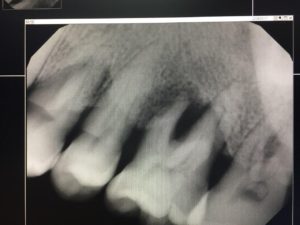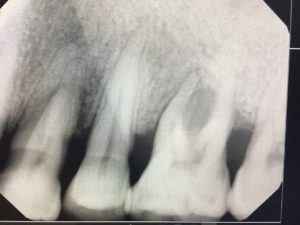Header logo
header top contact widget
Periodontitis
Scared? Afraid? Simple Steps To Get Past Dental Fears.
Posted on Apr 30, 2019 by William J. Claiborne, DDS MS
If you’re one of those people who have no dread of going to see a dentist, be glad. For the large percentage of adults who do experience anxiety or fear associated with dental visits, they are actually in the majority.
In the U.S., an estimated 70 percent of adults have some level of dental fear, unfortunately. About 5-10 percent of them can be categorized as “dental phobics.” These individuals have such an intense fear of dental visits that the mere thoughts of walking into an office causes reactions such as sweating or more rapid breathing.
As a periodontist, I’m a frequent witness to just how severe dental fears can be. Some people cry, some keep a white-knuckled grip on the arms of a dental chair (once they finally talk themselves into one), and some ask to be put to sleep for things as minor as dental cleanings.
 The periodontal specialty provides patients with a dental professional who has advanced training in the diagnosis and treatment of gum disease. It also covers the diagnosis and placement of dental implants, which are the “ideal” tooth replacement. In this field, I’ve seen the repercussions of both due to dental fear.
The periodontal specialty provides patients with a dental professional who has advanced training in the diagnosis and treatment of gum disease. It also covers the diagnosis and placement of dental implants, which are the “ideal” tooth replacement. In this field, I’ve seen the repercussions of both due to dental fear.
By not receiving regular dental cleanings and exams, the risks for developing gum disease rise significantly. And, since gum disease is the leading cause of adult tooth loss, it plays a key role in one’s potential to lose natural teeth.
Dental fear leads to a vicious cycle of poor oral health and tooth loss. When people are too afraid to see a dentist for regular care and fail to have small problems repaired while treatment needs (and costs) are still minimal, the process is ongoing. As gum health declines, the risks for tooth loss increases.
No one wants to end up in dentures. While TV commercials for denture adhesives or same-day denture clinics try to come across as upbeat, life wearing a denture is anything but. Long-time denture wearers struggle to bite, chew, and even speak without worrisome, uncomfortable slips or rubbing against tender gum tissues.
Too, the uncertainty of a denture can make some people uneasy when dining out or in other social settings. It’s not unusual for denture wearers to decline invitations when food is a key centerpiece of the gathering. This is sad. It is also detrimental to one’s health. Social involvement is an important part of our overall well-being.
If you are among those who avoid dental care because of uncontrollable jitters or downright “scared” feelings, below are several steps you may wish to consider to help you move past them:
• Begin by writing down what you believe caused your fears in the first place. Was it a painful procedure? Was it a rough dentist who ignored your obvious discomfort? If you know what sparked your fear in the first place and can look-it-in-the-eye in actual words, you can begin to deal with them. This may help you bring them out of the shadows and into the light where you can begin to conquer them.
• Close your eyes and imagine your life with a healthy smile — one that makes you feel good about being close to others. Imagine conversations having fresh breath and smiling with confidence. Imagine getting compliments on your smile! Think about how you may interact more confidently with others with a smile you’re proud to share.
• If you haven’t seen a dentist on a regular basis, you may need to begin with a periodontal examination. You can do an internet search (Periodontist) in your area and get to know them through their web sites. Read the doctor’s bio and become familiar with what he or she offers in terms of technology and comfort options. When a periodontist keeps current on the techniques and technology surrounding this specialty, patient comfort is typically a leading factor among these features.
• Visit the periodontist’s office after hours. Yes, go there when they are closed so you’ll feel less intimated. Sit in the parking lot and imagine where you’d park for your visit, once scheduled. Walk up to the entrance and become familiar with the look of the entryway. This way, when your appointment is made, you’ll feel more comfortable making your way in the door.
• Call the office and be comfortable sharing your concerns. Don’t feel shy about saying, “I have a lot of dental fear and would like to begin by meeting the doctor.” Most offices have these conversations with new callers more often than you realize. As mentioned prior, dental fear and anxiety are fairly common. Most offices offer an initial consultation so you can get to know the doctor before scheduling an exam. Ask about where this consult will be held. The periodontist should have a private room available for this, where it is not part of the clinical side of the practice.
• The day of your appointment, call the office and ask about anticipated waiting time for your appointment. Most offices run on-time and your wait should be less than 15 minutes. However, unforeseen emergencies do arise that may disrupt an on-time schedule. If delayed, consider rescheduling. Having a lengthy wait time may add to your anxiety and it may be best to arrange another visit.
• When you go, take a book, newspaper, or favorite magazine for your wait time. Don’t assume that the periodontist has a selection you’ll be interested in. Some people like to work a crossword or ‘Jumble’ during their brief wait here.
• When meeting the doctor or staff, know that it is important to be straight-forward about your fear level. Don’t gloss over it. Being upfront will help the doctor tailor your care to address your fears or concerns at an appropriate level.
• Ask the doctor about comfort options, including sedation. Both oral and IV sedation (twilight sleep) should be available. Feel free to ask questions about how they are administered, recovery time, and safety monitoring measures. Your safety is as important as your comfort.
• Finally, listen to your gut. Did you feel the doctor truly ‘heard’ your concerns? Did you feel the staff was attentive? Did you feel confident in the appearance of the practice? Sometimes, the most important measure of comfort is what that “little voice” inside is telling us. If you don’t feel good about moving forward, consider a consult at another periodontal office. You should leave your consult feeling positive about moving forward.
One of the most satisfying parts of my specialty is watching a once-fearful patient transform into one with a healthy, confident smile! And, the foundation of that is a relationship of trust between the doctor and the patient.
If you are ready to get past your dental fears so you can have the smile you desire, begin by calling our Asheville periodontal office and speaking with our friendly staff at: 828-274-9440. Or, start with the steps listed above and move at a pace that feels best for you.
Our Newest Feature – Technology That Enhances Treatment, Even Reverse Some Damage
Posted on Mar 24, 2019 by William J. Claiborne, DDS MS
Introducing…
LANAP PROTOCOL USING PERIOLASE MVP-7
Dr. William Claiborne and Dr. Jennifer Boyland of Biltmore Periodontics in Asheville are pleased to announce the addition of LANAP® protocol, a laser treatment for gum disease. Both Doctors are now Certified LANAP Clinicians, which requires completion of intensive training.
disease. Both Doctors are now Certified LANAP Clinicians, which requires completion of intensive training.
LANAP is an acronym for Laser-Assisted New Attachment Procedure, which provides an advanced protocol to more efficiently and effectively treat periodontitis (advanced gum disease). The LANAP protocol allows Dr. Claiborne and Dr. Boyland to treat gum disease with the PerioLase® MVP-7™ laser. This offers a minimally invasive (non-surgical) treatment alternative for patients with moderate to severe periodontal disease.

BEFORE (area of bone loss around tooth roots)
LANAP treatment is patient friendly, leaves very little discomfort, and has a quick recovery time. Most patients can resume normal activities in less than 24 hours after treatment. Best of all, LANAP protocol is extremely effective in battling gum disease.

AFTER (showing bone regeneration)
The LANAP protocol uses the PerioLase® MVP-7™ laser instead of a knife or scalpel, avoiding any kind of cutting into the gums and the need for stitches. This reduces the level of discomfort following the procedure. Treatment through LANAP can be performed in as little as one session. It is safe for patients with health concerns such as diabetes, heart disease, and hemophilia.
Additionally, LANAP protocol can even stimulate bone regrowth in damaged areas. For example, it has been shown to regrow periodontal ligament, alveolar bone (the bony ridge that supports the upper teeth), and regrow the bony film that adheres teeth to the jaw. (see BEFORE and AFTER images above)
There are many advantages to this remarkable technology for the patients of Biltmore Periodontics. To learn more about LANAP protocol using the PerioLase MVP-7, as well as other advanced technology the practice features, visit: https://www.biltmoreperiodontics.com/services/advanced-technology/ or call their office at: 828-274-9440.
Recent Posts
Categories
Archives
- September 2024
- August 2024
- July 2024
- June 2024
- May 2024
- April 2024
- March 2024
- February 2024
- January 2024
- December 2023
- November 2023
- October 2023
- September 2023
- August 2023
- July 2023
- June 2023
- May 2023
- April 2023
- March 2023
- February 2023
- January 2023
- December 2022
- November 2022
- October 2022
- September 2022
- August 2022
- July 2022
- June 2022
- May 2022
- April 2022
- March 2022
- February 2022
- January 2022
- December 2021
- November 2021
- October 2021
- September 2021
- August 2021
- July 2021
- June 2021
- May 2021
- April 2021
- March 2021
- February 2021
- January 2021
- December 2020
- November 2020
- October 2020
- September 2020
- August 2020
- July 2020
- June 2020
- May 2020
- April 2020
- March 2020
- February 2020
- January 2020
- December 2019
- November 2019
- October 2019
- September 2019
- August 2019
- July 2019
- June 2019
- May 2019
- April 2019
- March 2019
- February 2019
- January 2019
- December 2018
- November 2018
- October 2018
- September 2018
- August 2018
- July 2018
- June 2018
- May 2018
- April 2018
- March 2018
- February 2018
- January 2018
- December 2017
- November 2017
- October 2017
- September 2017
- August 2017
- July 2017
- June 2017
- May 2017
- April 2017
- March 2017
- February 2017
- January 2017
- December 2016
- November 2016
- October 2016
- September 2016
- August 2016
- July 2016
- June 2016
- May 2016
- April 2016
- March 2016
- February 2016
- January 2016
- December 2015
- November 2015
- October 2015
- September 2015
- August 2015
- July 2015
- June 2015
- May 2015
- April 2015
- March 2015
- February 2015
- January 2015
- December 2014
- November 2014
- October 2014
- September 2014
- August 2014
- July 2014
- June 2014
- May 2014
- April 2014
- March 2014
- February 2014
- January 2014
- December 2013
- November 2013
- October 2013
- September 2013
- August 2013
- July 2013
- June 2013
- May 2013
- April 2013
- March 2013
- February 2013
- January 2013
- December 2012
- November 2012
- October 2012
- September 2012
- August 2012
- July 2012
- June 2012


